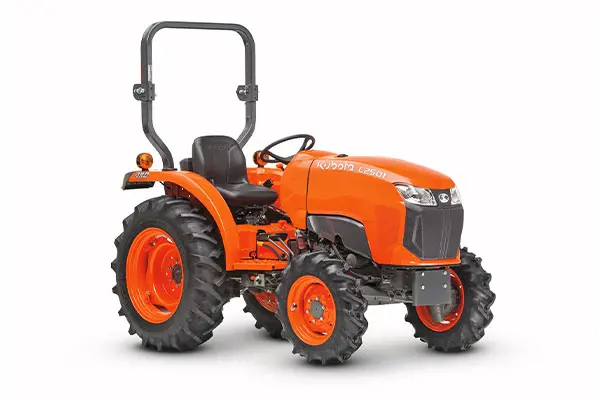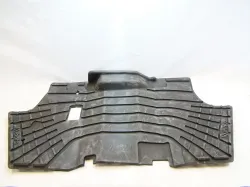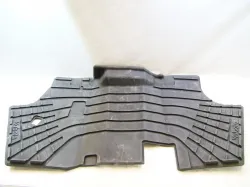New Mid-Size Compact Tractor. Kubota L4802
Tags : kubota-l4802 | kubota-standard-l |If you're shopping for a tractor, you will realize pretty quickly that Kubota's product line is fairly complex. You have a line of very deluxe tractors over in the Grand L series, machines like the L3560 at 35 horsepower, the whole way up to the L6060 at 60 horsepower. That's the line of extremely deluxe tractors that sits in that 35 to 60 horsepower range. There's an equivalent line of tractors that has a little bit more variety in the models over in the standard L range. Those 60 series models are considered grand tractors, very deluxe machines. On the standard size, you're going to have a number of models that fill in that line of economy utility tractors that lack some of the very deluxe electronic features that you find on their high-end models. That series is going to start at the L2502 through the 3902 that's a small frame. This tractor then steps in above that at the L4802, and then you'll move up into the MX series that fills in between 54 and 60 horsepower.
There's a lot of variety in those machines. While they're all considered standard utility-oriented tractors, they sit on different size frames and have very different construction from one to the next. This tractor, the L4802, these numbers always mean something. The 48 tells us that it's 48 gross horsepower. It's going to come in right about 46 net horsepower. That's just a little bit more than the outgoing model was, even though they share exactly the same engine. The block that's used in this tractor as far as the engine goes is used from 35 horsepower tractors clear on up to 60 horsepower tractors. Usually, when you're buying that block in a lower horsepower implementation, you have a little bit more displacement. You're usually buying a little bit more torquey engine than when that same engine is used at the top end of the horsepower range. I would expect that while you've got great horsepower here, it should be a very well-performing engine once you start to load it up.
Along with the new tractor comes a new loader. This loader is not radically different from the old one. I see a couple of differences in the way some of the hoses and hard lines are routed, but the most significant difference is the inclusion of a grill guard that is able to have brush guard inserts put into it. As years have gone by, we see many more people using grapples on their tractors now, and the aftermarket, including us, we sell custom-made brush guards, have picked up on the need to fill in these gaps here in order to prevent sticks from punching back into your tractor. Kubota's paid attention to what's happening out there on the aftermarket, and they're now offering factory brush guards to go inside of this grill guard. You're going to notice these square holes that are on here. There's an inexpensive kit that can fill in these openings so that if you're using your tractor in a woody environment, or you're using a grapple, you can add some protection here to the front end in order to protect something from coming back, busting up your headlights or punching into your grill. It's cool to see Kubota offering that, not just that they're paying attention to what's happening with tractors after they're sold, but when they do it with the scale that they can bring, rather than these brush guards costing several hundred dollars, you're paying about half to have them do it as an OEM option compared to what you would pay to have an aftermarket weld company work something up for the front of the machine.
On the topic of brush guards, there's a handful of things here that I look for in a tractor when you're going to be using your machine in an off-road or rugged environment. It's a tractor after all, right? You're going to go beat the thing around a little bit, at least I hope you do. When you look here at the loader valve, you'll notice that the hoses for the loader are all inboard here of the loader. They're not hanging here on the outside of the machine. That keeps a branch or something from coming by and catching one of these hoses and pulling it off. Not only is that the case for the loader valve to the loader hoses. It's also the case for the hoses that feed up to the loader valve itself. Everything there is very tidy. If you go around the tractor, you look at the location of the filters, the hydrostatic and the hydraulic filter in this case are both up above the support frames for the loader. When you look on the underside of this tractor, it's very clean across the bottom. You don't have things dangling down and things that are problematic, let's call it that. You'll see some tractors where you have a hydraulic filter on the bottom of the tractor that's the lowest point on the machine or very exposed on the underside of the tractor. When you're driving through woods and stuff, it doesn't take a whole lot for a stick to pop up and catch that filter, clean it off, and you're not going to know it until damage has been done to your machine. I like what I see on this model when taking that kind of perspective. The support rails for the loader are all below the hydraulic filters. There's good protection on the underside of this tractor from things that could cause damage. Another upgrade that's on this tractor over the prior model is the fuel filter assembly that's being used. This one is much larger, so it should have a longer service life, but it also has a drain here on the bottom in order to let water out of the bottom of the fuel filter. One of the most common problems that we see in our shops is related to bad fuel, whether it's water in it or algae. Many, many of the repair issues that we work on as a dealership are related to bad fuel in the tractor. I like that this fuel filter is very visible from the seat. You can sit there, look down, and very easily see it from the operating position. If you have water in your fuel, you'll start to see a line develop in here, or there's an O-ring float at the bottom that will sit in that layer between the fuel and the water. They want to separate from each other. If you get water, then you can open up this valve on the bottom and drain the water out of the bottom of the filter. That's a nice improvement on this tractor because you can do it without removing the entire fuel bowl. You just crack this open and let the water drain out. The prior model had a fuel filter in the same position. It was a smaller one, and it didn't have this valve on the bottom. It's a nice upgrade in terms of serviceability.
Another minor but meaningful improvement from the prior model is the location of the PTO switch. Most tractors now have moved over to this rotate and bump style knob. I like it. To turn it on, you push it down and turn it. That will engage your PTO. To turn it off, you just tap it there with your hand, and it pops right off again. It makes it easy to turn off your motor mower or your rototiller. You implement at the end of your headland turns. It's just pop it, and it turns off. It's handy. On the old model, though, rather than being right here out in front in a comfortable position, it's located behind you here a little bit at the back where the levers and stuff are on your right-hand side. Small change. It probably moved 18 inches or so, but it's in a more comfortable operating position. One new feature that's not on the prior one is the addition of a button up here on the dash for parked PTO. It's common on most tractors that if you want to operate the PTO while you're not in the seat, the tractor is going to shut off. That makes it difficult to use things like PTO generators or wood chippers where you're using your machine as a power plant when you're not in the seat. You can understand why most companies shut their tractors off when you get off the machine because that's often a safety concern, right? You have a spinning shaft and operating PTO with no operator in the seat. This tractor will allow that because it has a button up here on the dash. It's going to disable the seat switch. If you have the parking brake set and the PTO on, you can push this button and be able to hop off the machine, and continue to run those implements.
You'll notice here that our standard tractor is getting a lot of surprisingly deluxe features, right? A lot of what makes this tractor standard anymore is really limited the transmission and a lot of those electronic features, but deluxe comfort-related items are making their way into this model now like the rubberized floor mat. The prior model on its way out, the 4701, just had a standard steel pan where you rest your feet. This one now is going to have a rubberized floor mat on it. What's cool is if you have the older model, the L4701, you can buy this rubberized floor mat out of the parts book and fit it onto your tractor. It can carry over. We'll have links there in the description if you'd like to buy one. It makes it very easy. The benefit of having a rubber floor mat is several. You'll notice as you get on and off of a tractor, particularly if you're in mud, or you have stones on your shoes, you will quickly start to scratch the paint on a metal floor pan very quickly and scratch it in deep ways, right to the point that you're going to get down to the metal., and rust is going to start to happen and take hold in that floor pan. The rubber there is going to protect that. It's going to keep the stones from grinding into things. It gives you a little bit better traction. It looks a little bit better, and it keeps your tractor quieter. That sheet metal floor pan that sits in there tends to resonate because it's bolted right onto the transmission. The rubberized floor mats also help to keep the noise of the machine down.
I'm sitting on the hydrostatic variant of this tractor. There is also a shuttle drive gear drive model available. Hydrostatics are going to make up about 80% or 90% of the sales of this model. It is the more popular configuration. I have a pedal down here on the floor for forward and reverse. You can operate that pedal either with heel-toe, or if you do what I do, I lift my toe underneath the pedal and lift up for reverse. There's a lot of different configurations of how you can operate this pedal. The tractor is going to come through with cruise control as standard equipment, so you have a lever over here on your left-hand side that's going to set your speed to a constant rate. It's good if you're going to go out and say, brush hog a 10-acre field. You don't have to keep your foot on that pedal and hold it at a constant speed. I also find it useful if I'm on really rough ground, and I'm bouncing around. Rather than having my foot bounce on top of the hydrostatic pedal, I can set the cruise control so that I'm not varying the speed of the tractor while I bounce around. It could be a useful feature on a tractor like this.
The back end of this tractor is exactly like its predecessor. Nothing has changed back here. This is a typical Category 1 3-point hitch. It's pretty normal for what you're going to see in Kubota's product range up until you get to above 50 horsepower. This is the large end for Category 1. You're going to find that you have a standard 3-point hitch here that does not have extendable link ends like you would find over on the Deluxe Series tractors. If you would like a feature like this, many of these machines are sold with three-point quick hitches now that negates a lot of the benefit of that extendable arm. You will find standard sway bars on this tractor. Most of Kubota's lower horsepower standard tractors come through with what's called a check chain, a less deluxe adjustment for that arm in the back.
These are going to come standard with sway bars. It's an upgrade on the other tractors. It's standard on this. Those sway bars make attaching implements to your 3-point hitch much nicer and more convenient. It's good to see it on this machine as standard equipment. If I'm totally honest, this tractor has not been a great seller for us. That really is because of the tractor here on your right. This is an MX Series tractor. It's Kubota's compact utility tractor, still sold with a hydrostatic transmission, but it's a little bit more horsepower in the 54 to 60-horse range. When you see these two tractors sitting side by side, you might pick up on some differences here. You'll see this tractor has a little bit heavier loader, much larger, chunkier front tire, and a Category 2 rear end. As years have gone by, we often look at these two machines and see that the price gulf between them had been small enough that most of our customers would migrate into the MX Series.
As some years have gone by and price increases and promotions have changed in these different models, the price difference between these machines is larger than it used to be. It's not that the MX got more expensive. It's that this tractor actually got cheaper. It's a little bit closer in price now to many of the other smaller standard L Series tractors. It's for that reason now that the gap between these two machines can approach $4,000 to $5,000. Many people are going to appreciate the Category 2 rear end and the heft and the bulk that comes in the MX, but this new pricing makes this tractor a lot more attractive. I think we're going to start to see our sales of it grow for that reason. Between the modernization of the machine, the updated styling, the value that it brings, I think it's a fantastic package.













